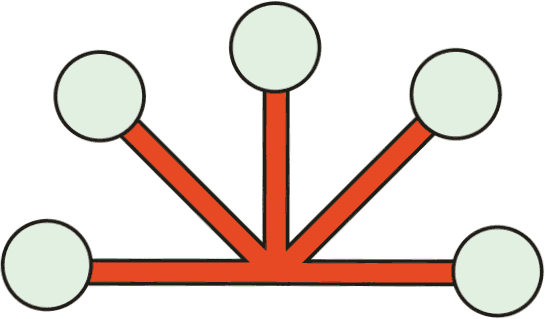The Constitutional Documents Issue
What good citizenship looks like at your company
Not sure where to start? This guide can help.
Derek Sivers said, “when you make a business, you get to make a little universe where you control all the laws. This is your utopia.”
Your constitutional documents are the laws for your little universe. All great organizations have their own way of doing things and their own particular views of how the world should work. By writing your constitutional documents, you are making explicit what yours are.
Once you do, you’re probably going to find that your version of utopia isn’t for everyone. This is something to celebrate. It doesn’t mean you want everyone to be the same; it only means that you want people who work extremely well together in pursuit of your company’s goals. It also means that you want everyone at your company to be clear about what they’ve signed up for.
You’ll know when your constitutional documents are right when you read a draft and say “now that feels like us.” And the wonderful people working with you or considering working with you will read them, light up, and say “that feels like me, too.” And then they’ll go on to recite and reference them with pride in meetings and presentations and coffee walks and kickoff docs and retrospectives and maybe even meals with people outside the company. Every company wants great citizens just like all employees want to be them.
Other issues
Not sure where to start? Select one or more tags below to filter the content of this zine:
Looking for:
- Nuts and Bolts
- Wrenches and Hammers
- Factory Favorites
- Recipe Under Development
Kool-Aid Serving Size:
- Kool-Aid Gulp
- Kool-Aid Sip
My role:
- Company Leader
- Crossfunctional Influencer
- Domain Expert / Team Lead
- Operator
Get more details on zine filters here
Filter descriptions
Looking for:
-
Nuts and Bolts
Foundational mechanisms to get started with. Most great organizations rely on their own version of this.
-
Wrenches and Hammers
Supplemental mechanisms to do more with. Many great organizations use these to close gaps or respond to challenges.
-
Factory Favorites
Lesser-utilized tactics that more companies could benefit from trying.
-
Recipe Under Development
Research on best practices and potential impact is still underway.
Kool-Aid Serving Size:
-
Kool-Aid Gulp
The highest-impact, furthest-reaching tactics for everyone to engage with.
-
Kool-Aid Sip
Nice-to-have or opt-in tactics for smaller groups to experiment with.
My role:
-
Company Leader
Someone with direct influence over the direction of the company and what is brought onto the company stage.
-
Crossfunctional Influencer
Someone who makes decisions across multiple teams or functional groups.
-
Domain Expert/Team Lead
Someone with strong command of a specific topic and/or the leader of a functional group.
-
Operator
Anyone getting work done with a command of the company’s values/standards and the inclination uphold them.
MISSION AND VISION
Early in a company’s life, some formalized document or a phrase TechCrunch can describe you with isn’t required for a shared sense of purpose. Building together is probably enough. But when you can no longer say with full-throated confidence that everyone at your company knows what future they are building towards and why, it’s time to write your mission and/or vision statement.
The mission statement is about establishing consistent language for describing what the company is working towards. It’s subtle, but using aspirational versus descriptive language can make a real difference in elevating the day-to-day work of your company.
Uber and Lyft don’t say “we help people give and get rides places.” Instead, the focus on the benefits to people and society. Lyft’s mission statement is: “Improving people’s lives with the world’s best transportation.” Uber’s mission statement says: “We ignite opportunity by setting the world in motion.” Stripe doesn’t say “we make payments better.” Instead they focus on their purpose around economic access and growth. Their mission statement is “increase the GDP of the internet.”
The vision statement goes further in pulling together the purpose and the product, the past, present and future, and the logos, pathos, and ethos, to tell the full story of the company. This is the one place to look into the future with optimism someone else could reasonably call delusion. No matter how far away the finish line is, and no matter how implausible getting there seems, a solid vision statement can help make the impossible feel possible.
Overall, the goal is to help a broader set of people grok and rally around your company’s direction. And that’s good for your team and it’s good for business.
Mission Statement
What everyone is working together to achieve, the one-liner
- Since a mission statement is mostly about what other people say, and aligning it on a singular phrase, make it something you and your team would be proud to say over dinner or in a meeting.
- Another company may have your same mission (in fact, there may very well be an incumbent that does). It’s how your team makes progress towards it that will really set you apart. (See: Operating Principles).
- There’s a fine line between ambition and hubris. Bias towards ambition by taking a clear-eyed look at what’s possible if your company was wildly successful. Steer clear of hubris by taking a clear-eyed look about the reach and impact your company can actually have.
HOT TIPS
Mission statements of great organizations:
- Hallmark: create a more emotionally connected world
- Nike: bring inspiration and innovation to every athlete* in the world. *If you have a body, you are an athlete
- Microsoft (in 1980): a computer on every desk in every home
- Google: “To organize the world’s information to make it universally accessible and useful.”
- SpaceX wants to make humanity multiplanetary. From their website: “You want to wake up in the morning and think the future is going to be great – and that’s what being a spacefaring civilization is all about. It’s about believing in the future and thinking that the future will be better than the past. And I can’t think of anything more exciting than going out there and being among the stars.” – Elon Musk
- Patagonia is “in business to save our home planet” From their website: “Patagonia grew out of a small company that made tools for climbers. Alpinism remains at the heart of a worldwide business that still makes clothes for climbing—as well as for skiing, snowboarding, surfing, fly fishing, mountain biking and trail running…. As the climate crisis deepens, we see a potential, even probable end to such moments, and so we’re fighting to save them. We donate our time, services and at least 1% of our sales to help hundreds of grassroots organizations all over the world so that they can protect what’s irreplaceable.”
COMPANY STORY
Vision Statement
What everyone is working together to achieve, the full story
- The best vision statements are often personal and include some explanation of why you decided there was nothing else in the world that you should do except for solve the problems your company is solving, and how you hope the world changes as a result of solving those problems.
- Go on and get a little dewey-eyed with ambition as you put pen to paper on this one. Get comfortable with writing something someone might roll their eyes at. Remember, you likely started your company because you know something someone else doesn’t.
HOT TIPS
- Primer’s Vision Statement strikes the balance between personal storytelling and clarity of greater purpose, a clear-eyed take on today’s reality and painting a picture of a better reality, the warm-and-fuzzies and the cold hard facts, ambition and humility. “Kids are remarkable — and our current system is underestimating them,” it declares with confidence. It’s hard to imagine not being roused into action after reading something like that!
- Our World In Data “publishes research and data to make progress against the world’s largest problems.” Their Vision Statement tackles the intrinsic link between understanding progress (which includes understanding problems) and making progress. “Personally I believe that if we are in a situation in which it is possible to make progress then we are obliged to seek progress. But even if you do not see it as an obligation, you can also see it as an opportunity, a chance to help others, the possibility to do useful work in your life.”
- Tesla’s Plans (Master Plan, and Master Plan Part Deux) are iconic examples of product strategy, company vision, personality, and ambitious thinking rolled into one.
- Dwell’s Fruitbowl Manifesto clarifies how they want to be a different kind of aspirational: “At Dwell, we’re staging a minor revolution. We think that it’s possible to live in a house or apartment by a bold modern architect, to own furniture and products that are exceptionally well designed, and still be a regular human being. We think that good design is an integral part of real life. And that real life is the thing that has been conspicuous by its absence in most design and architecture magazines.”
COMPANY STORY
HOT TIPS
OPERATING PRINCIPLES
In 2001, Enron, one of America’s largest companies, went bankrupt and several of its leaders were sentenced to prison for accounting fraud. Their stated values at the time were “Respect, Integrity, Communication and Excellence.” I’m sure those words made for very nice posters and slide decks and maybe even some corporate swag. But the way *not* to be Enron is to help everyone invoke and lean on the values while the work is actually happening.
One way to do that is to frame these as operating principles instead of values. Values are static while operating principles are dynamic, designed to be invoked in the run of work to guide behavior.
Facebook’s “move fast and break things,” is probably the most well-known example.
You can imagine how much clarity this brought to decision-making and what kinds of action invoking this mantra permitted and encouraged its employees to take. You can also imagine the point at which this spirit stopped serving the company. In 2014, ten years into the company’s life, Facebook updated their iconic operating principle to “move fast with stable infra.” “It might not have the same ring to it and might not be as catchy,” CEO Mark Zuckerberg acknowledged, “but it helps us build better experiences for everyone we serve and how we operate now.”
Operating principles are meant to evolve. It’d be kind of strange to update your values at any regular cadence, but operating principles can (and should) change as the needs of the business and organization change.
When you establish your operating principles, you are creating a contract between all employees, in any corner of your organization and at any level, that states:
- “I believe that striving to do this will make our work better, and ultimately help us succeed”
- “This is how I will strive to act when I am working with you”
- “I want you to act this way with me when you are working with me”
- “When I lose sight of these values, please remind me. I will do the same for you”
Any organization requires a massive amount of coordination between all different kinds of people, with all different styles, and all different charters. A shared agreement about how to get the work done and how to make decisions between reasonably good options is going to make the work better and bring your team closer. It should be impossible to get through a day at your company without hearing them.
Operating Principles
How everyone agrees to strive to act when working together
- Good operating principles are both reflective and aspirational. They express how everyone agrees they want to work on their best days, and help get things back on track on the hard days.
- Having a shared language for your operating principles is what’s going to make them useful in the run of work when it really counts and helps all of your team members connect over them. It should be unusual to get through a day without hearing one used.
- Every phrase should easily roll off the tongue. When writing yours, role play the scenarios in which you hope someone would use a phrase to identify someone doing great work or to course-correct something that’s going off-track.
HOT TIPS
- Google’s original “Ten Things We Know to Be True” is a manifesto about the beliefs everyone should share, and how to work with them in mind.
- Netflix’s famous ‘culture deck’ intermingles their operating principles with other employee expectations and company norms. It made ripples for being so explicit about its expectations for employee behavior and performance.
- At Stripe, new hires sign the company values. Here’s what they publish externally about the company culture and what anyone joining the company to expect it to feel like.
- At VMware, partnerships are encouraged to fall 51%/49% in favor of the partner.
- Twilio has a ‘No Shenanigans’ operating principle (among others) which translates to “be thoughtful. always deal in an honest, direct, and transparent way.” It’s a friendly and breezy way to say what might otherwise be a hard thing.
- a16z publishes the same values to their public site as they do to their internal team.
- The Chatham House Rule states “When a meeting, or part thereof, is held under the Chatham House Rule, participants are free to use the information received, but neither the identity nor the affiliation of the speaker(s), nor that of any other participant, may be revealed.” It was created in 1927 to encourage openness in debates on controversial topics.
- IDEO created the “Little Book of IDEO” to “to attempt to address some of the eternal questions that we are asked.”
- Teamflow’s operating principles state “We recognize that they aren’t for everyone. That’s fine. We don’t mean that this is the only way people should work. It’s just our way — and we totally understand and respect people who decide it’s not for them.”
- Amazon: 1/ Customer Obsession 2/ Ownership 3/ Invent and Simplify 4/Are Right, A Lot 5/ Hire and Develop the Best 6/ Insist on High Standards 7/ Think Big 8/ Bias Towards Action 9/ Frugality 10/ Earn Trust of Others 11/ Dive Deep 12/ Have Backbone: Disagree and Commit 13/ Deliver Results
- Uber (early days, modeled after Amazon): 1/ Always Be Hustlin’ 2/ Be An Owner, Not A Renter 3/ Big Bold Bets 4/ Celebrate Cities 5/ Customer Obsession 6/ Inside Out 7/ Let Builders Build 8/ Make Magic 9/ Meritocracy & Toe-Stepping 10/ Optimistic Leadership 11/ Super Pumped 12/ Champions Mindset/Winning
- Uber (after CEO transition): 1/ We build globally, we live locally 2/ We are customer obsessed 3/ We celebrate differences 4/ We do the right thing 5/ We act like owners 6/ We persevere 7/ We value ideas over hierarchy 8/ We make big bold bets
- The Montessori Education Principles: do an outstanding job of outlining what’s unique about their approach while also explaining how and why they arrived at it.
- The Gimbal is a guide to X’s moonshot factory culture. It combines stunning photography that shows the scale/craft of their work with a crisp articulation of values and navigational tips for “figur(ing) out what to try when you’re not sure what to do.”
COMPANY STORY
- Getting your team to embrace these is just as important as getting the content right. If your team doesn’t fully wrap their arms around these and use them while the work is happening, they are ultimately not that useful.
- Invite your very early team members to comment on and edit the operating principles.
- Spotlight stories of people upholding them in spectacular ways or doing something hard or inconvenient in service of them by adding them to your operating principles document. It should be an honor to have your work included there.
- Do an onboarding session with new employees that encourages discussion on what each principle means to them. Ask what feels surprising or hard to imagine upholding. It can be a powerful force for discovering work style preferences and any lingering scar tissue from other companies.
- Operating principles must be modeled by company leaders. Over time, no matter what, the inner voice of employees will start to match the outer voice of their leaders. They can also be coupled with norms like a McKinsey-style “obligation to dissent,” or Netflix’s courage value that explicitly asks employees to “question actions inconsistent with [their] values.”
ROLLOUT PLAN
“If you aren’t having these explicit conversations about what your culture is, the downsides are threefold: You don’t have the right people joining you, and you’re being unfair to those who do join you, in the sense that they end up being surprised by this emergent friction and tension in work styles. Thirdly, and I think this may be the non-obvious one, people’s disposition with regard to the company is actually a function of what they feel like they signed up for. If they feel like they signed up for an all-encompassing project, they’ll be much more willing to treat it that way than if they discovered it by surprise later on. And so you can actually change the outcome simply by being explicit at the outset.“
-Patrick Collison, founder and CEO of Stripe
The full interview about what’s so important about setting expectations about how the work gets done is worth a read.
RESOURCE




















